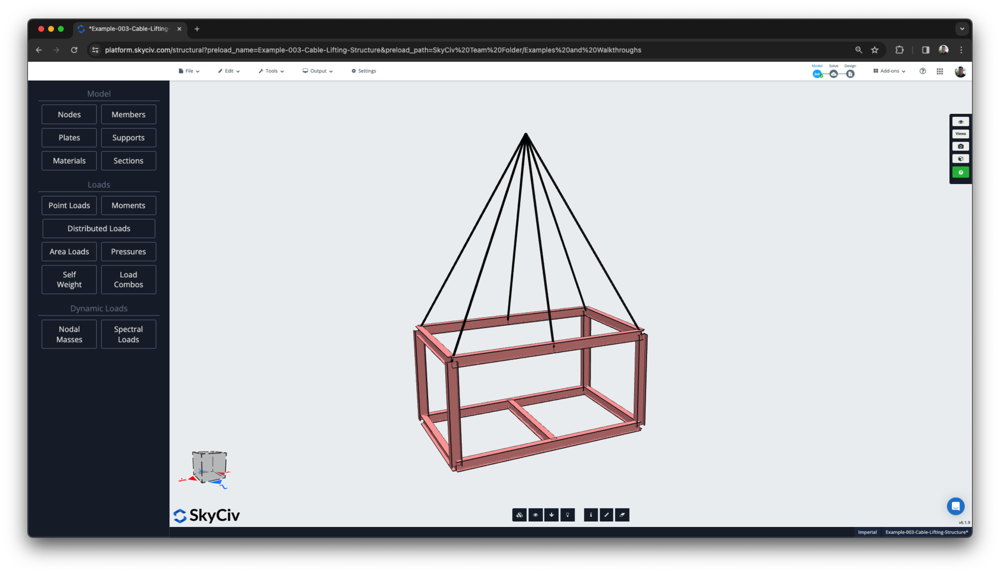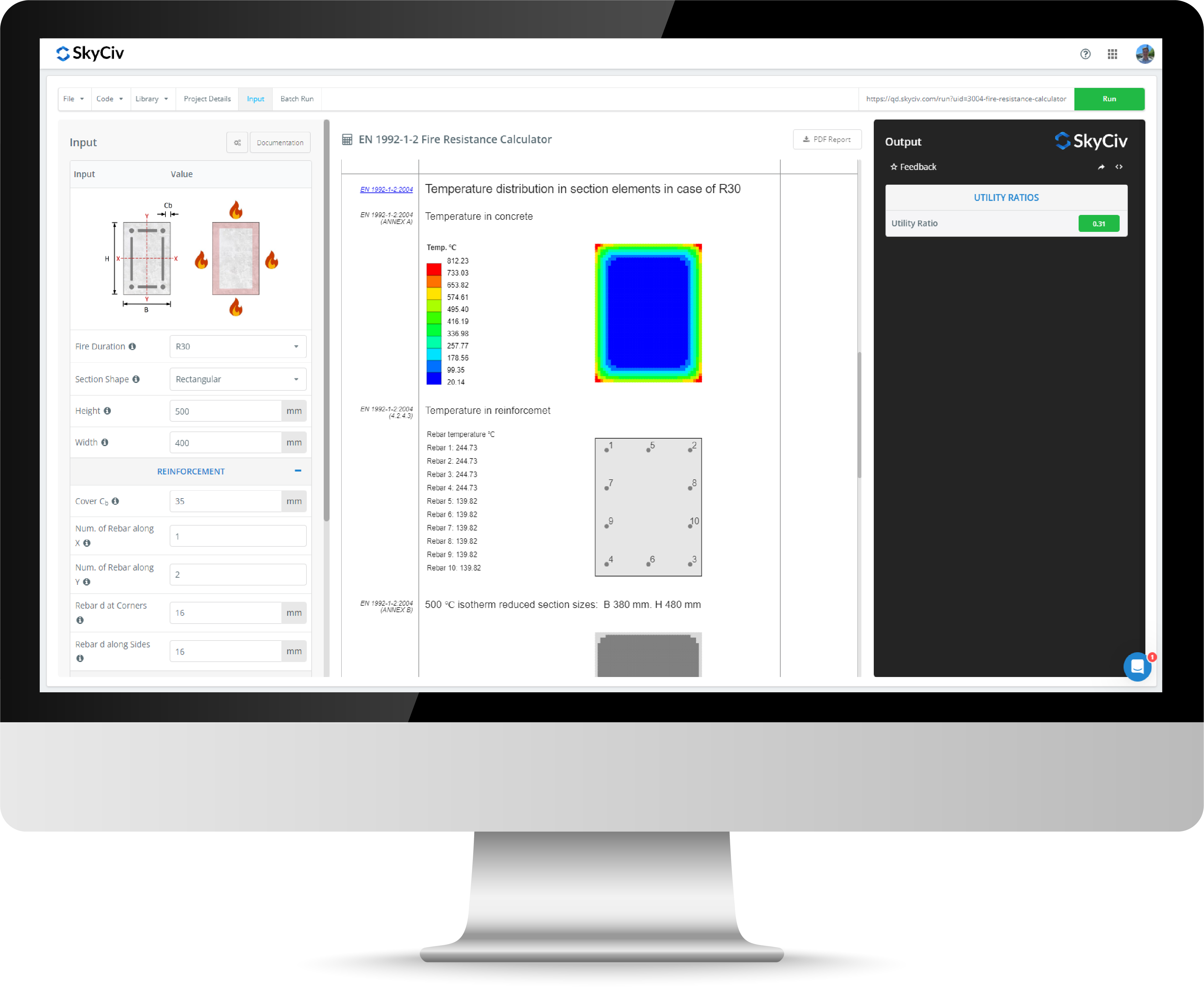Cable Tension Calculator
Cables are an important and efficient structural element that need special consideration during design. The below calculator is an easy-to-use tool that will calculate the following values based on user input:
- The applied Tension Force in the Cable
- The Tensile Stress in the Cable
- Elongation from this Load
- Thermal Elongation from a Change in Temperature (if provided)
- Utility Ratio of how close the cable is to failure based on the material yield strength
With this quick calculation, engineers can make quick design decisions with clear output and a more detailed design report if needed. The calculator provides the option to select from two systems:
- 1-Cable simple system, with a single cable and single vertical load
- 2-Cable system, where a single cable is carrying the weight from two anchor points and two different (or the same) angles. The calculator will calculate the tension in each cable and provide individual capacities for each cable.
- Pulling Cable System - this will calculate the cable pulling tension due to the friction forces caused from pulling an object along a surface. This calculation requires the coefficient of friction between two surfaces. Some sample and common values have been provided in the info tip for this input.
In both systems, the applied load will be distributed to calculate tension in a cable and any thermal load (or thermal change) will also be used to calculate the thermal expansion in the cable elements.
About this Tension Cable Calculator
How to Calculate tension in a Cable?
To calculate tension in a cable, engineers generally use first-principles statics. For a structure to be in equilibrium and static (i.e. not moving) it will need to satisfy the equilibrium equations:
Σ Fy = 0
Σ Fx = 0
i.e. all forces in the X and Y direction should sum to zero
This basic principle forms the basis of all calculations when working out the tension in a cable.
Example 1: Calculate the tension in the cable of a simple 1-Cable Structure
In the below simple example, given P = 500kg, what is the tension in the cable?
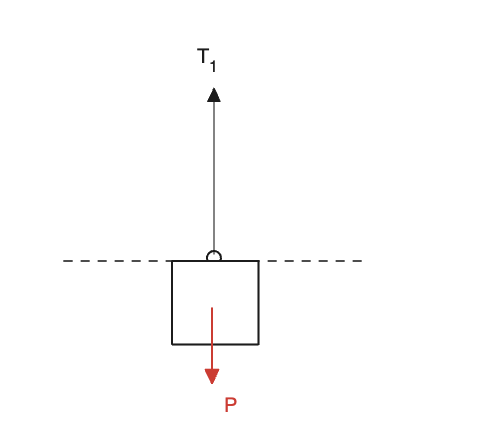
Well in this case, the sum of forces in Y (vertical) must equal zero. Since there is no force in the x (horizontal) we can ignore Σ Fx = 0, since this is already true.
Σ Fy = 0
0 = -500 + T1
T1 = 500kg
∴ the tension in the cable is 500kg (also can be noted as 500kg x 9.81 = 4.91 kN)
Example 2: Calculating the Tension in a 2-Cable System
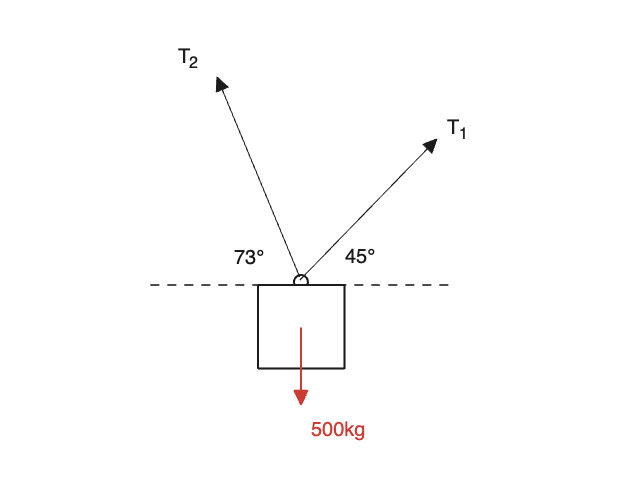
Given angles α1 = 45° and α2 = 73° with a load of 500 kg.
Since we have two equations, and two unknowns (T1, T2) we will be able to solve this system. First, consider the two equilibrium equations.
Σ Fy = 0: T1 sin(α1) + T2 sin(α2) = P
Σ Fx = 0: T1 cos(α1) = T2 cos(α2)
Solving for T2 in terms of T1 from the horizontal condition gives us:
T2 = T1 (cos(α1)/cos(α2))
T2 = 2.4185 T1
Substituting T2 into the vertical condition, we get:
T1 (sin(α1) + (cos(α1)/cos(α2)) sin(α2)) = P
T1 = P / (sin(α1) + (cos(α1)/cos(α2)) sin(α2))
T1 = 500 / (sin(45) + (cos(45)/cos(73)) sin(73))
T1 = 165.56 kg (or 1.624 kN)
Cable Elongation Calculations and Cable Elongation Formula
Elongation is the concept that the cable will stretch when it is tensioned. The distance at which this stretches is known as elongation and is represented as a change of length (ΔL). Once you have the tension in the cable, you can calculate the elongation (ΔL) in the cable due to the load.
The basic cable elongation formula (which is also used the above tension cable calculator) is:

Thermal Cable Elongation Calculation and Thermal Elongation Formula
Steel will generally expand under higher temperatures. To account for this, the calculator will also allow users to enter in a change of temperature to calculate the thermal expansion of the material and the elongation in the cable. This is based on the following thermal elongation formula:

Δtemp = the change in temperature
L = the original length of the cable
α = Coefficient of Thermal Expansion (for steel, the value is typically within the range of 10e-6 to 12e-6 m/m°C)
Cable Pulling Tension Calculator
The above calculator can also be used to calculate the tension caused by the friction forces of pulling a weighted object along a surface. As you pull a weight, given by P below (and in the calculator), a friction force is applied in the opposite direction to which it is being pulled. This is evident from the below free body diagram:
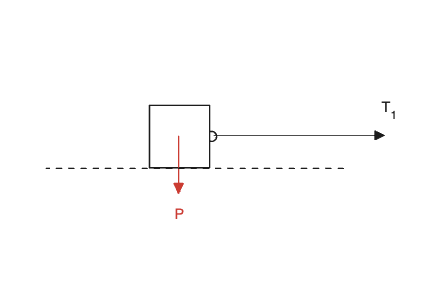
The calculator will then proceed to calculate the stresses and elongations caused by this pulling tension force. The cable pull tension calculation is a pretty simple one, and just involves multiplying the vertical force by the coefficient of friction:
F = μ · N
- F is the force due to friction (in newtons, N),
- μ is the coefficient of friction between the surfaces in contact,
- N is the normal force (in newtons, N), which is the force perpendicular to the surfaces in contact. For horizontal surfaces, the normal force is typically equal to the weight of the object, N = m · g, where m is the mass of the object (in kilograms, kg) and g is the acceleration due to gravity (approximately 9.81 m/s2 on the surface of the Earth).
Other Calculators
About SkyCiv
As well as this cable tension calculator SkyCiv offers a wide range of Cloud Structural Analysis and Design Software for engineers. As a constantly evolving tech company, we're committed to innovating and challenging existing workflows to save engineers time in their work processes and designs.
FAQ?
How to use the Cable Tension and Thermal Elongation Calculator?
To use the SkyCiv Cable Tension Calculator, follow these steps:
- Open the calculator on your device.
- Input cable properties:
- Cable Parameters such as Cable Length, Cable Diameter (or Area), Material Properties, such as Young's Modulus and Thermal Properties)
- Input load values:
- Applied Load (P): This should be a factored load to ensure a factor of safety is provided in your designs
- Thermal Change (T): This is the change of temperature that the cable is undergoing. For instance, before installation the cable might be stored and measured at room temperature, say 20°C. However, in the final design the cable might be near plant equipment, or under direct sunlight which means the design temperature could be 50°C. The change in temp would be entered as +30°C
- Cable Yield Strength (Fy): This is optional but will provide some calculation of utility (how much of the material is being used before it fails)
- Based on your inputs, the calculator interface will display the maximum and minimum: shear, moment, and displacement values as well as the Shear Force Diagram, Moment Diagram, and Displacement Diagram.
What if I need to calculate more complex cable systems?
SkyCiv has a fully-features structural analysis software called SkyCiv Structural 3D, which supports catenary cable analysis. These are structural elements that are non-linear and tension only with large displacements. They have zero capacity for flexural or shear forces, but capable of carrying load in tension.
You can model and solve pretty much any cable system in 3D, as we are running a full FEA on the system, whereas this calculator runs more of a simple case analysis. Here is an example of a cable structure in SkyCiv Structural 3D. Learn more at Cables in SkyCiv Structural 3D.
